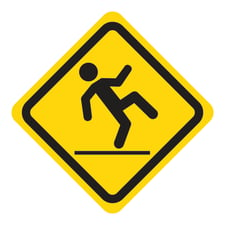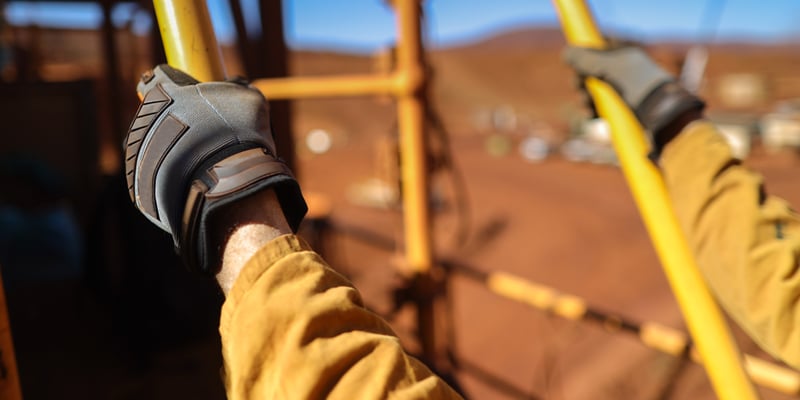
By
Rob Boyle
October 10, 2024
Updated
October 10, 2024

What are slips, trips, and falls?
The phrase "slip, trip, and fall" may initially seem redundant, but these are three distinct types of safety hazards, all three of which can result in injury and equipment or property damage.
What is the difference between slips, trips, and falls?
Slips, trips, and falls constitute the majority of general industry accidents. Second only to motor vehicle accidents, slips, trips, and falls are the most frequent accidents leading to personal injury.
Slips, trips, and falls can result in head injuries, back injuries, broken bones, cuts and lacerations, or sprained muscles. Slip, trip, or fall hazards on some jobs, such as working on the derrick, on the rig floor, or on raised decks can be deadly.
Slips
A "slip" occurs when there is too little traction or friction between the shoe and walking surface, most often resulting in the person falling backward. Slip hazards are created when liquids, ice, or other materials interfere with the traction between the floor and a person’s feet. Injuries from slips can include broken bones, back injuries, and bruises.
Trips
A "trip" occurs when a person’s foot makes contact with an inappropriately placed object, such as an electrical cord, storage box, pipe, or tool, in their way or when a person drops to a lower level unexpectedly causing them to be thrown off-balance. People that trip over something can either fall forward to the ground or into another object. They can still suffer broken bones and bruises even when they catch themselves. Equipment and tools can also be broken.
Falls
A "fall" occurs when you are too far off-balance and can be life threatening. Each year there are many fatal incidents in the industry, and numerous workers are injured. A wide range of protections are available, including guardrails, fall arrest systems, safety nets, covers, and travel restriction systems.
 What causes slips, trips, and falls?
What causes slips, trips, and falls?
- Dry floors with wood dust or powder
- Uneven walking surfaces
- Polished or freshly waxed floors
- Loose flooring, carpeting or mats
- Transition from one floor type to another
- Damaged or irregular steps and no handrails
- Shoes with wet, muddy, greasy or oily soles
- Electrical cords or cables
- Weather hazards – rain, sleet, ice, snow, hail, frost
How can I prevent slips, trips, and falls?
A common cause of falls while ascending or descending stairs is “stair hopping.” Stairs should be ascended or descended one tread at a time and only while using the handrail.
If you observe unsafe conditions on stairways, do not assume that someone else will report them. Inform your supervisor or maintenance personnel immediately so that a repair or clean up can be carried out as quickly as possible.
The importance of handrails
Many of the disabling injuries from falls on the job occur on stairs. Statistics show that injuries from these accidents are mostly fractures and sprains, but these statistics refer only to falls that keep people from their jobs.
There are plenty of other tumbles that cause painful cuts and bruises, but they don’t keep the victim away from work. Falls down stairs are taking a large toll of lives each year at home as well as on the job. Many of these stairway falls could have been avoided if handrails had been used.
The concept of the handrail is basic. If you slip, trip, or begin to fall while ascending or descending a staircase, grabbing the handrail can break your fall and save you from serious injury.
Yet, most people neglect the use of it. Building codes for stairs and ramps are justifiably very rigorous because stairway accidents can cause severe injury and even death. There may be several reasons people hesitate to use handrails.
If they have ever used a wooden handrail that was not kept in good repair, they probably have had the painful experience of gathering a handful of splinters.

Obviously, the point should be made here that handrails should be kept in good repair. Be sure to report any rails that are loose or rough.
Good design can substantially reduce the potential for miss-stepping by providing users with the means to retrieve their balance, but even the best design cannot eliminate falling hazards entirely. The fact is that some incidents can be caused by inattention, unsafe behavior, and inappropriate footwear.
Another reason for reluctance to use handrails is that they slow your descent. However, the awful speed with which you reach the bottom of the stairs when you fall makes the time lost through handrail use seem unimportant.
Do I need to use handrails when going up the stairs?
Using handrails is important to your safety not only when you are going down stairs but also when you go upstairs. A miscalculation of a fraction of an inch when stepping up can send you sprawling with painful results. Any hesitation about using handrails tends to disappear toward the end of the day when tired bodies often look to handrails for support.
Many stairway accidents are caused when people insist on carrying a load that is too much for them to handle, or the load obscures their vision to the extent that they miss a step. If you must carry objects up or down a stairway, the load should be small enough to allow one hand to be free to hold the railing.
Another important safety factor is good housekeeping. Stairways should be kept clear of trash and other tripping hazards. Stairways are not storage areas, and any obstructions should be reported to your supervisor or cleared immediately. Often, stairways are posted with signs urging pedestrians to be cautious and to use handrails.
Safety standards point out that any flight of stairs with four or more risers should have a handrail. There’s a good reason for this, so don’t wait to fall to find out what it is. Use handrails!
